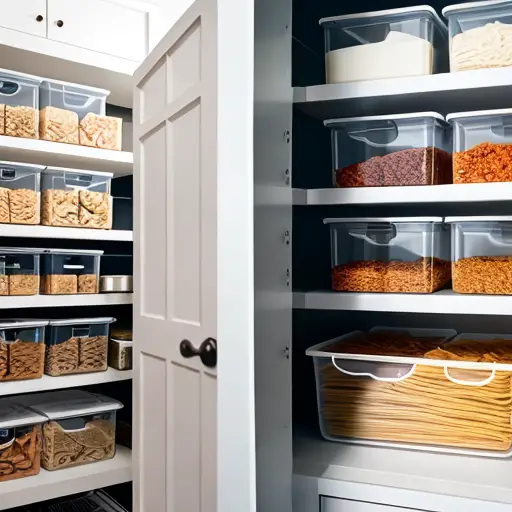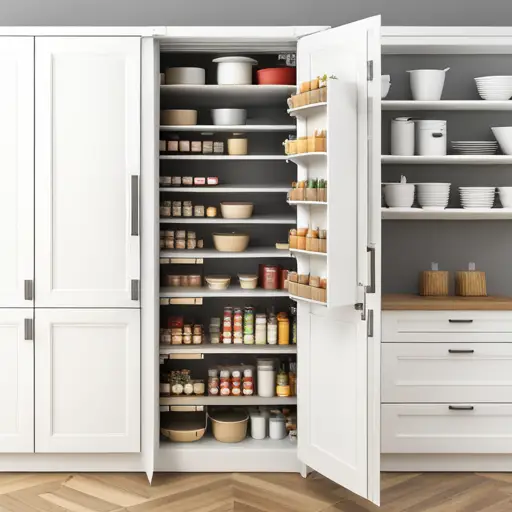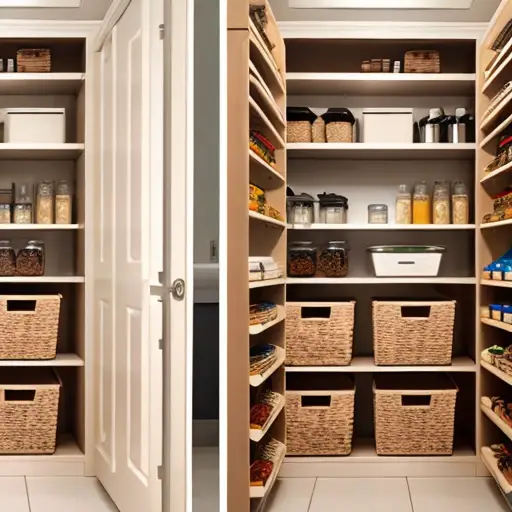Are you a pasta enthusiast who wants to know how to store pasta in the pantry? Look no further! In this article, we will explore the art of pasta storage and provide expert tips to ensure your pasta stays fresh and delicious for extended periods. Whether you’re a seasoned chef or a novice cook, understanding the proper techniques for storing pasta is essential to maintaining its quality. So, let’s dive in and discover the secrets of storing pasta in the pantry!
This is how to store pasta in the pantry. Opt for airtight containers over their original packaging for enhanced protection. Ensure containers are tightly sealed and placed in a cool, dry area. Regular pantry organization ensures older pasta is used first, maintaining freshness.
How to Store Pasta in the Pantry?
There are a few key factors to consider when storing pasta in the pantry. Let’s break it down and explore each aspect in detail.
Choosing the Right Packaging
To begin with, it’s important to select the right packaging for your pasta. When purchasing pasta from the store, opt for packages that are made of durable and airtight materials. Look for resealable bags or boxes that will help preserve the freshness of the pasta and protect it from moisture and pests.
Keeping Pasta in its Original Packaging
Once you’ve purchased the pasta, keep it in its original packaging whenever possible. Thanks to the packaging’s design, the pasta will stay fresh and will not pick up smells or moisture from the environment. However, if the original packaging is damaged or unsuitable for long-term storage, consider transferring the pasta to airtight containers.
Using Airtight Containers
The best way to store pasta in the pantry is in airtight containers. They provide additional protection against moisture, pests, and stale air. Choose containers specifically designed for food storage with a reliable sealing mechanism. Glass or plastic containers with tight-fitting lids are ideal.
Properly Sealing the Containers
When transferring pasta to airtight containers, ensuring a proper seal is crucial. The pasta’s taste and freshness will be preserved as a result. Remove any extra air by gently pressing down on the pasta before sealing the containers. Next, firmly seal the lid to produce an airtight atmosphere.
Store in a Cool and Dry Place
Store your pasta in optimal condition in a cool and dry place in your pantry. Avoid exposing the pasta to direct sunlight or extreme temperature changes, as these can affect its quality. Ideally, the pantry should have a temperature between 50°F (10°C) and 70°F (21°C) with low humidity levels.
Organizing the Pantry
Maintaining an organized pantry is crucial for proper pasta storage. Keep your pasta containers away from strong-smelling ingredients, such as spices or cleaning products, as the pasta absorbs odors easily. Additionally, rotate your pasta stock, using the “first in, first out” principle, to ensure that older pasta gets used before newer purchases.

How to Store Pasta So You Don’t Get Bugs
Keeping pasta bug-free is essential for maintaining the quality and safety of your food. Here’s a guide on how to store pasta to prevent bugs and keep it fresh:
- Inspect Before Purchase: Before buying pasta, inspect the packaging. Ensure that the package is sealed without any tears or holes. This will help you ensure that the product hasn’t been compromised.
- Use Airtight Containers: Once you open a package of pasta, transfer any unused portion to an airtight container. These containers prevent bugs from entering and keep the pasta fresh. Containers made of glass or thick plastic are usually the best choices.
- Store in a Cool, Dry Place: Pantry pests and bugs thrive in warm, humid environments. Ensure your pasta is kept cold, dry, and away from heat and moisture sources. This will help deter bugs and keep the pasta from becoming stale.
- Regularly Clean Your Pantry: Make it a habit to clean and inspect your pantry. Wipe down shelves, check for signs of pests, and discard old or infested food items. A clean pantry is less inviting for bugs.
- Use Bay Leaves: Placing bay leaves in your pasta container or pantry shelves can be a natural deterrent for bugs. Most pests don’t like the scent of bay leaves.
- Rotate Stock: Practice the “first in, first out” principle. When you buy new pasta, move the older packages to the front so they get used first. This reduces the chance of pasta sitting too long and becoming a potential bug target.
- Check Other Foods: Bugs infusing pasta can also infest other grains and dry goods. Regularly check items like flour, rice, and cereals for signs of bugs.
- Seal Other Food Items: Just as you store pasta in airtight containers, you should do the same for other dry goods. This makes it less likely for bugs to find a source of food in your pantry.
- Buy in Reasonable Quantities: If you live in a household with few people or don’t consume pasta frequently, consider buying in smaller quantities. This ensures that you’re using it up before it has a chance to become infested.
- Consider Freezing: If you’re concerned about pests or have had bug problems, you can freeze dry pasta for 48 hours before transferring it to the pantry. This can help kill off any potential larvae or eggs that might be present.
Remember, the key is prevention. Storing pasta correctly and maintaining a clean pantry can significantly reduce the risk of bugs entering your food.
The Right Way to Store Pantry Essentials
Certainly! Storing pantry essentials properly can prolong their shelf life, maintain flavor, and help prevent bug infestations or spoilage. Here’s a guide on how to store some common pantry items:
Grains and Pasta:
- Use airtight containers to keep out moisture and pests.
- Store in a cool, dark place.
- Consider labeling with the purchase date to track freshness.
Flour:
- Store in an airtight container.
- Consider refrigerating or freezing for longer shelf life, especially for whole-grain flours that contain more oils.
- Regularly check for pests or any off-smells.
Sugar:
- Keep it in an airtight container to prevent moisture absorption, which can lead to clumping.
- Store in a cool, dry place.
Salt:
- Store in a cool, dry place.
- Use salt containers with tight-sealing lids.
Baking Ingredients (baking soda, baking powder):
- Keep them in their original containers or airtight containers.
- Store in a cool, dry place.
Spices and Herbs:
- Store in a cool, dark place, as light can degrade their flavors.
- Use airtight containers.
- Consider purchasing whole spices and grinding as required because ground spices lose flavor faster than whole spices.
Canned Goods:
- Store in a cool, dry place.
- Rotate stock: use the oldest items first.
- Check for any signs of bulging or rust; these can indicate spoilage.
Oils:
- Store them in a cool, dark place to prevent them from becoming rancid.
- Some oils, like sesame or walnut, have a shorter shelf life and may benefit from refrigeration.
Vinegar:
- Store at room temperature.
- Ensure caps or lids are tightly sealed.
Dried Beans and Legumes:
- Use airtight containers.
- Store in a cool, dark place.
- Rotate stock to use older beans first.
Nuts and Seeds:
- Due to their oil content, they can become rancid. Keep in a cold, dry location in an airtight container.
- For longer storage, consider refrigerating or freezing.
Dried Fruits:
- Store in airtight containers.
- Keep in a cool, dark place.
Coffee and Tea:
- Coffee, especially once ground, loses flavor rapidly. Store in an airtight container away from light. For longer storage, consider the freezer, but ensure it’s well-sealed.
- Tea should be in an airtight container in a cold, dry location.
Potatoes and Onions:
- Store in a cool, dry place, but not together, as they give off gases that can affect each other.
- Don’t store them in plastic; use mesh bags or baskets for ventilation.
Inspect pantry items regularly for any signs of spoilage, infestation, or unusual odors. Regularly cleaning and organizing your pantry will help maintain the quality of your essentials.

How Long Does Homemade Pasta Last in the Fridge?
Fresh homemade pasta will last in the refrigerator for 1-2 days when stored properly.
Drying Homemade Pasta for Long-Term Storage:
- Spread the pasta out on a drying rack or hang it to dry. Ensure it’s in a dry, well-ventilated area.
- Allow drying thoroughly, which might take several hours to a couple of days, depending on the thickness of the pasta and the humidity.
- After drying, keep it in an airtight container in a cool, dry area.
Storing Fresh Pasta Without Sticking:
- The key is to prevent the pasta from clumping together. Lightly dust with flour or semolina.
- If stacking pasta, use parchment or wax paper between each layer (like lasagna sheets or cut shapes).
Freezing Fresh Pasta:
- Lightly flour the pasta to prevent sticking.
- Put foods like ravioli or other stuffed pasta on a baking sheet and freeze until firm. After that, move to freezer bags or airtight containers.
- Store in the freezer for up to 3 months.
How Long Does Fresh Pasta Last in the Freezer?
If stored in an airtight container or freezer bag, fresh pasta can be preserved in the freezer for up to three months. Remember that these recommendations only apply to pasta without any perishable food fillings. Pasta with meat or dairy ingredients may require different storage conditions and have a shorter shelf life. Always rely on your senses; it is preferable to throw out pasta if it smells odd or changes texture.
Storing Fresh Pasta Overnight
Purpose: Sometimes, you make pasta a day in advance. It must be stored carefully to preserve its flavor and texture.
- Method: After making the pasta, sprinkle it with a light coat of flour to prevent it from sticking together. This is especially vital for long strands of pasta like spaghetti or fettuccine.
- Storage: Place the floured pasta in an airtight container or a tightly sealed plastic bag, ensuring there’s minimal air inside.
Storing Fresh Pasta in the Fridge
Purpose: Refrigeration slows down bacterial growth, extending the freshness of your pasta for a short time.
- Method: Similar to overnight storage, always flour the pasta lightly.
- Duration: Fresh pasta, when refrigerated, remains at its best for 1-2 days. After this, it can start to develop a stale texture and flavor.
Storing Fresh Uncooked Pasta
Purpose: Sometimes, you may want to prepare pasta in advance but need more time to cook or consume it.
- Method: Always rely on refrigeration for short-term storage. For longer storage, freezing is your best bet.
- Duration: Use within 1-2 days if refrigerated. If you don’t plan on using it within that window, move to freeze.
Storing Fresh Pasta in a Jar
Purpose: Though unusual, someone might wish to present fresh pasta as a gift or for aesthetic reasons.
- Method: Always ensure the pasta is well-floured to prevent sticking. Seal the jar tightly.
- Duration: When stored in a jar, use within 1-2 days, especially if refrigerated.
Drying Homemade Pasta for Long-Term Storage
Purpose: Drying pasta allows for prolonged shelf life without refrigeration.
- Method: Spread out the pasta, ensuring no pieces overlap. You can use specialized pasta drying racks or improvise with clean clothes hangers. Ensure adequate ventilation and no direct sunlight.
- Duration: Once dried, pasta can be stored in a cool, dry place for several months.
Storing Fresh Pasta Without Sticking
Purpose: Fresh pasta has moisture. If pieces touch, they can fuse, ruining their shapes.
- Method: Toss or dust the pasta with flour or semolina. If stacking, like sheets of lasagna, use parchment paper between layers.
Freezing Fresh Pasta
Purpose: Freezing allows for the longest storage duration.
- Method: Lightly flour the pasta, especially if they are filled with varieties like ravioli. Pre-freeze individual pieces on a tray before transferring them to a storage bag or container for best results. This ensures they don’t stick together.
- Duration: Frozen fresh pasta can be stored and used within 3 months. After this, while it might still be safe to eat, the texture and flavor can degrade.
Remember, these practices apply to plain fresh pasta. If you’re dealing with filled pasta (like ravioli with meat or cheese), ensure you’re aware of the specific storage needs of the fillings. Always trust your senses when it comes to food. If it smells, looks, or feels off, it’s safer to discard it.

FAQs
Can I freeze pasta for long-term storage?
Yes, freezing pasta is an excellent option for long-term storage. Pasta that has already been cooked can be stored in sealed containers or freezer bags for up to three months. The pasta should be cooked al dente (slightly undercooked) before freezing since freezing may change the texture of the food.
Should I refrigerate pasta instead of storing it in the pantry?
Although it can increase the shelf life of pasta, cooling is optional for most dry pasta varieties. Following the instructions, you can keep pasta fresh in the cupboard for several months. However, refrigeration can be viable if you live in a hot and humid climate or the pantry is prone to temperature fluctuations.
Can I reuse the original packaging for storing pasta?
Reusing the original packaging for storing pasta is not recommended, as it may not provide adequate protection against moisture and pests. Transferring the pasta to airtight containers ensures freshness and prevents contamination.
How long can I store pasta in the pantry?
Properly stored, dry pasta can retain its quality for up to one year in the pantry. However, before using the pasta, it’s important to check for any signs of spoilage, such as unusual odors, discoloration, or pests.
Can I store different types of pasta together?
Storing different types of pasta together is generally fine as long as they are properly sealed in airtight containers. However, if you have flavored or colored pasta, storing them separately is advisable to prevent any flavor transfer.
Can I store homemade pasta in the pantry?
Homemade pasta is best consumed fresh. However, if you’ve made more than you can consume immediately, you can store it in an airtight container in the pantry for up to one week. It’s important to check for any signs of spoilage before using homemade pasta.
Conclusion
In conclusion, knowing how to store pasta in the pantry is essential to maintain its freshness and flavor. Using the advice in this article, you can ensure that your pasta remains delectable for a long time. Remember to choose the right packaging, use airtight containers, seal them properly, and store the pasta in a cool and dry place.
Additionally, organizing your pantry and practicing proper rotation will help maintain the quality of your pasta stock. With these guidelines, you can confidently stock your pantry with pasta and enjoy delightful meals whenever desired!

